Universal Scientific CF114100 Wireless LAN CF Card User Manual 1
Universal Scientific Industrial Co., Ltd. Wireless LAN CF Card 1
Users Manual Revised 091202

USI 802.11b WLAN
CF Card
Quick User Guide

Special Issue Regarding to the Configurations of the WLAN CF Card
This WLAN CF Card, is designed and classified as a HAND-HELD device. It is
designed to be adapted with the hand-held device such as PDA, PocketPC,
Palm etc. The configuration other than these usage (e.g. with the body-worn
manner) is not intended by the manufacturer and is strictly prohibited. In
addition, for your own safety, it is recommended that keeping at least 20cm
separation between the device and your body to minimize the possible RF
exposure.
This device must not be co-located or operating in conjunction with any
other antenna or transmitter in order to avoid mutual interference.

Index
1. Introduction..................................................................................................................... 4
1.1 Network Scenarios................................................................................................ 4
1.2 Features................................................................................................................. 4
2. Installing and Configuring the Wireless Network for Pocket PC................................... 6
2.1 Preparation ............................................................................................................ 6
2.2 Installing the Driver and Utility from a CDROM................................................ 6
2.3 Configuring the Wireless Network in Windows CE............................................ 8
3. Using the Client Manager Utility.................................................................................. 15
3.1 Installing the Client Manager ............................................................................. 15
3.2 The meaning of Tack Tray Icons........................................................................ 15
3.3 Using the Client Manager ................................................................................... 15
4. Card Specifications ....................................................................................................... 18
4.1 Physical Specifications ....................................................................................... 18
4.2 Power Characteristics ......................................................................................... 18
4.3 Networking Characteristics................................................................................. 18
4.4 Radio Characteristics .......................................................................................... 19
Basic Troubleshooting ...................................................................................................... 21

Index of Flow Chart
Figure 1 ............................................................................................................... 5
Figure 2 ............................................................................................................... 7
Figure 3 ............................................................................................................... 8
Figure 4 ............................................................................................................... 9
Figure 5 ............................................................................................................. 11
Figure 6 ............................................................................................................. 12
Figure 7 ............................................................................................................. 13
Figure 8 ............................................................................................................. 14
Figure 9 ............................................................................................................. 16
Figure 10 ........................................................................................................... 16
Figure 11 ........................................................................................................... 17
1. Introduction
Wireless LAN is local area networking without wires, which uses radio
frequencies to transmit and receive data between PC’s or other network
devices without wires or cables. Wireless LAN configurations include
independent networks suitable for small or temporary peer-to-peer
configurations and infrastructure networks, offering fully distributed data
connectivity via micro cells and roaming.
The USI 802.11b WLAN CF card allows Pocket/Handheld PC
(Windows CE 3.0 or 4.0) devices to connect to a Wi-Fi TM IEEE 802.11b
wireless local area network (LAN), or communicate directly with other
devices enabled for wireless LAN connectivity.
The USI 802.11b WLAN CF card is designed to meet the mobility,
performance, security, interoperability, management, and reliability
requirements of IEEE 802.11b high data rate standard.
1.1 Network Scenarios
1.2 Features
Features includes:
• CompactFlash TM form factor fits devices with CF Type I and Type II
extended card slots
• Functions with Pocket/Handhelp PC (Windows CE 3.0 or 4.0) devices
with CF Type I and Type II extended card slots
• Compliant with 11 Mbps 802.11b high-speed specification
• Data rate 11/5.5/2/1 Mbps automatic fallback under noisy environment
• Power Management for decreased power consumption
• Interoperable with IEEE 802.11b compliant equipment
• Supports full mobility and seamless roaming from cell to cell
• User-friendly client manager utility
• Supports 64 and 128-bit WEP (Wired equivalent privacy).
• Direct Sequence Spread Spectrum (DSSS) technology provides robust,
• interference-resistant and secure wireless connection.
• Wireless connection without the hassles and cost of cabling.
• Greater flexibility to locate or move networked device
• The USI 802.11b WLAN CF Card has only one LED indicators
o Transmit/Receive (flashing green)
o Power ON/OFF LED(flashing red)
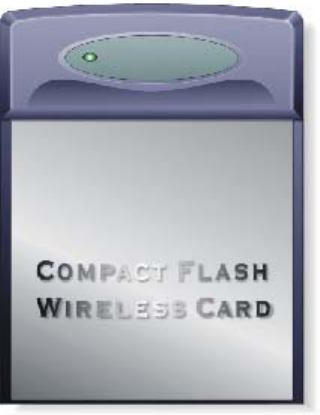
Figure 1
2. Installing and Configuring the Wireless Network for
Pocket PC
2.1 Preparation
Before beginning the installation, prepare the following hardware and
software:
• A USI 802.11b WLAN CF Card
• A Software and Documentation CDROM for USI 802.11b WLAN
CF Card
• A Pocket PC(or Handhelp PC) with CF Type I and Type II
extended card slots
• A Sync cable
• A Desktop computer with a CDROM drive
2.2 Installing the Driver and Utility from a CDROM
To download the driver and utility from the Software and Documentation
CDROM to a Pocket PC in a Windows CE 3.0 or 4.0 environment:
[NOTE]: Refer to the documentation shipped with the Microsoft ActiveSync
program to ensure the desktop computer used in the driver installation meets the
system requirements for the ActiveSync program.
1. Connect the sync cable to a serial or USB port between the desktop
computer and the Pocket PC.
Once a connection exists between the desktop computer and the
Pocket PC, file transfers and data synchronization can take place.
2. Insert the Software and Documentation CDROM into the CDROM
drive on the desktop PC.
3. Run the setup program(setup.exe) from the folder
CD:\Win_CE\CE300 or CD:\Win_CE\CE400
Follow the sequential setup-instructions on Desktop PC screen to
finish installation.
4. Insert the USI 802.11b WLAN CF Card into the CF slot.
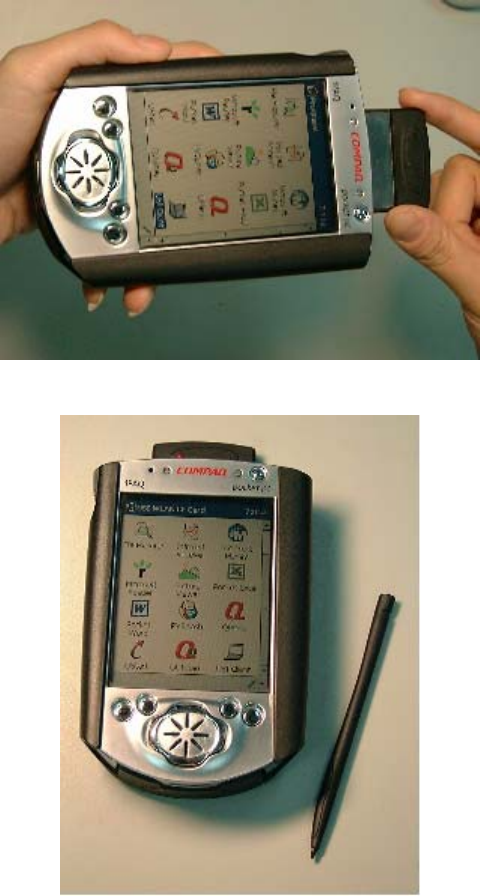
Figure 2
The Client Manager utility(See chapter 4) will be executed and
hidden on the task bar of the Today screen
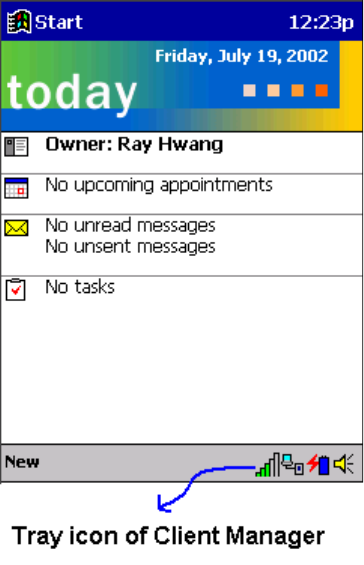
.
Figure 3
2.3 Configuring the Wireless Network in Windows CE
To configure the Wireless Network in a Windows CE environment.
1. Insert the USI 802.11b WLAN CF Card into a CF slot of the Pocket
PC.
2. Click the “USI WLAN Settings(CF)” icon to run the Wireless
Networking Setting utility from StartÆSettingsÆSystem
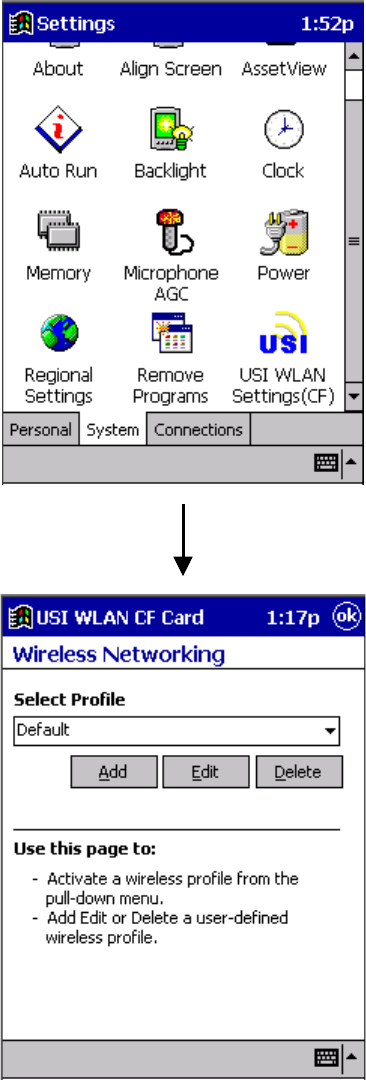
Figure 4
You can:
¾ (I) Select a profile and click the “OK” button to switch your station
from one wireless network to another
¾ (II) Click “Add” or “Edit” button to add or edit the selected profile.
¾ (III) Click “Delete” button to delete the selected profile
(I) “Select a Profile”
You can select a configuration profile to switch your station from
one wireless network to another.
[NOTE]:Before you can start using Configuration Profiles, you have to
add a Configuration Profile for each wireless network environment that
you want to participate in with your (mobile) Wireless Client Station. If
you plan to use your Wireless Client Station in multiple networking
environments that require different configuration settings, you can define
dedicated profiles for each environment. For example you can create a
Configuration Profile for:
• your office head quarters
• a branch-office
• your home or SOHO network
After creating configuration profiles, you can easily switch your station
from one wireless network to another by selecting one of the profiles.
(II) “Add/Edit” Configuration profile
¾ Assign a name to your wireless configuration profile and select
the Network Type to identify the type of wireless connection
for this profile.
Access Point
Residential Gateway
Peer-to-Peer Group
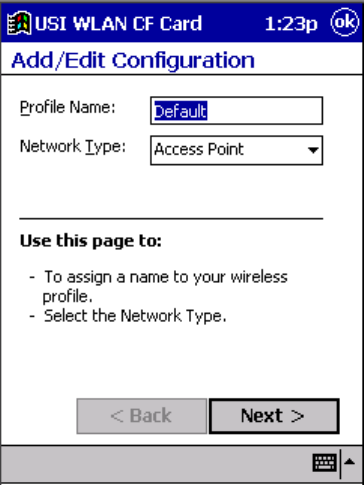
Figure 5
Click “Next” button to setup the Network Name
¾ Setup the Network Name
Use this screen to identify the Network Name of the wireless
network to which you wish to connect your computer.
• When connecting to a Base Station, consult the LAN
Administrator of the network for the correct value, or use
the Scan button to retrieve a list of open wireless
networks
• When connecting to a Peer-to-Peer Group, consult one
of the workgroup participants for the correct value.
Valid value is a case-sensitive string of ASCII printable
characters with a maximum of 32 characters. The value ANY
will allow your computer to connect to the first open Base
Station network that it can find.
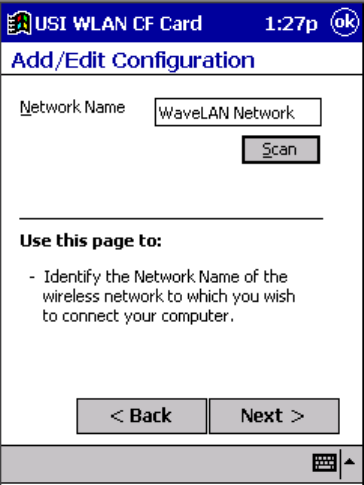
Figure 6
Click “Back” button to go back the last setting screen
Click “Next” button to setup the encryption key.
¾ Security Settings
Use this screen to:
• Enable or disable wireless data encryption
• Enter the encryption key that applies in your network.
You can enter key values in either Alphanumeric Value or
Hexadecimal Value. The encryption key value is case-
sensitive. Consult your LAN Administrator for the correct
value.
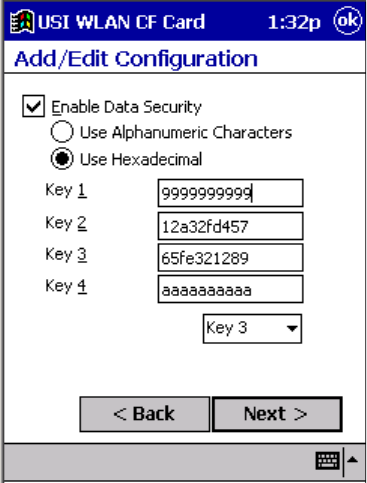
Figure 7
Click “Back” button to go back the last setting screen
Click “Next” button to enable/disable the power saving
¾ Card Power Management
Use this screen to:
• Enable Power Management for low power
consumption and wireless performance.
• Disable Power Management for default power
consumption and high wireless performance (default).
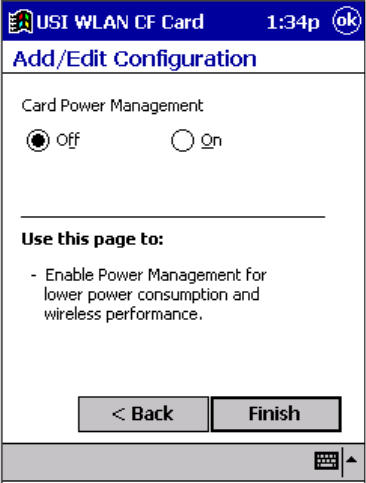
Figure 8
Click “Back” button to go back the last setting screen
Click “Finish” button to finish the setting job
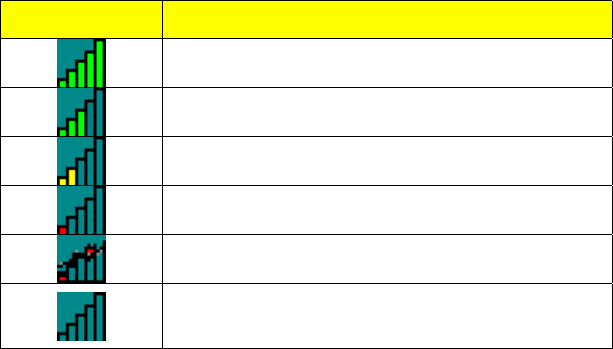
3. Using the Client Manager Utility
3.1 Installing the Client Manager
The Client Manager utility comes bundled with the USI 802.11b WLAN CF
Card driver on the Software and Documentation CDROM.
Once you complete the driver installation instructions described in Chapter
3 and insert the card into Pocket PC, the Client Manager utility will be
executed and hidden on the task bar of the Today screen.
You can use the Client Manager to do “link test” and “site survey”. The
Client Manager task tray icon conveys real-time signal strength and
connection status. The Client Manager also displays the driver and
firmware revision data. Alternatively, you can configure the USI 802.11b
WLAN CF Card by clicking the tray icon on the task bar.
3.2 The meaning of Tack Tray Icons
ICON Status
Excellent connection
Good connection
Marginal connection
Poor connection
No connection
No quality info availablw(no driver,
incompatible driver, etc)
3.3 Using the Client Manager
Click the tray icon to enter the Client Manager screen and see the wireless
network status.
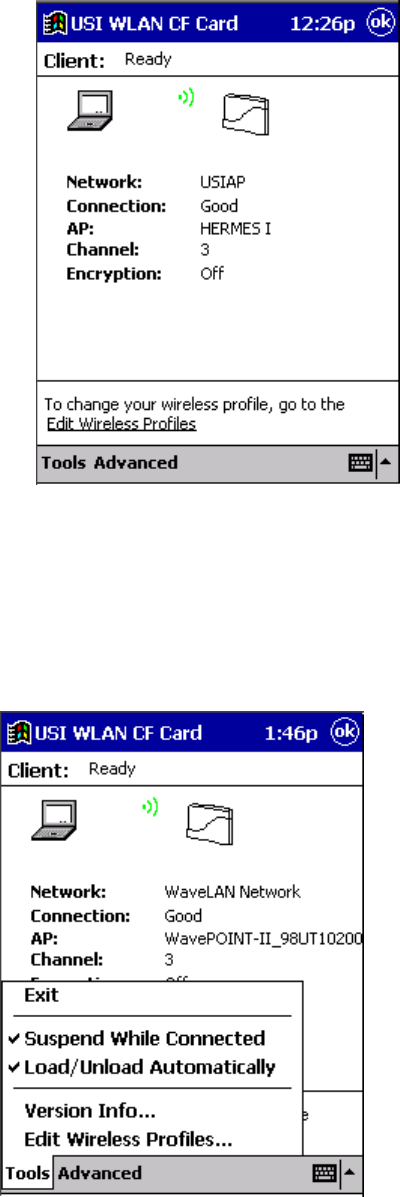
Figure 9
You can use the “Tools” pop-up menu to
• enter the Configuration profile edit screen
• see the driver and firmware revision
• enable/disable the settings “suspend while connected” and
“Load/Unload automatically”
• suppress the Client Manager(hidden on the task bar)
Figure 10
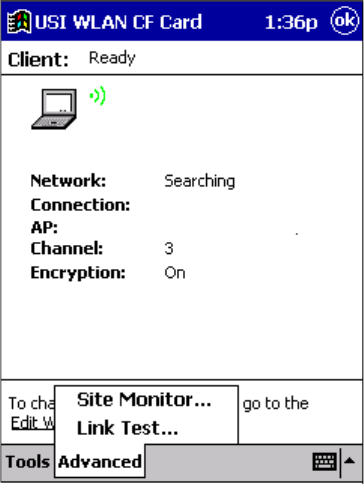
You can use the “Advanced” pop-up menu to
• scan the Access points in range and monitor them
• select a partner to do link-testing
Figure 11
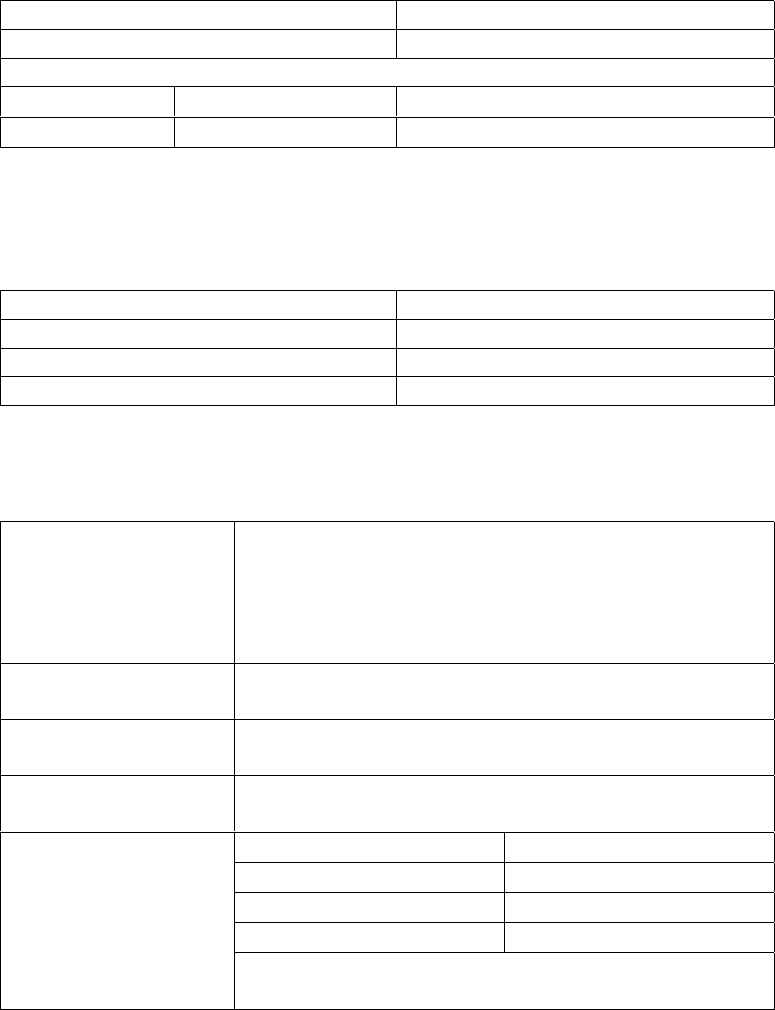
4. Card Specifications
4.1 Physical Specifications
Form Factor CF Card Type I Extended
Dimensions 52.5x42.8x5 mm
Temperature & Humidity
Operation 0° to 60° C Maximum humidity 95%
Storage -10° to 70° C 10 to 90%(no condensation)
4.2 Power Characteristics
Doze Mode 10 mA
Receive Mode 180 mA
Transmit Mode 280 mA
Power supply 3.3 V
4.3 Networking Characteristics
Compatibility • IEEE 802.11 Standard for Wireless LANS
(DSSS)
• Wi-Fi (Wireless Fidelity) certified by the
Wireless Ethernet Compatibility Alliance
(WECA).
Network Operating
System
Microsoft Windows Networking
Host Operating
System
Windows CE 3.0 & 4.0
Media Access
Protocol
CSMA/CA(Collision Avoidance) with
Acknowledgment(ACK)
• High 11 Mb/s
• Medium 5.5 Mb/s
• Standard 2 Mb/s
• Low 1 Mb/s
Data Rate
The card use an automatic Transmit Rate Select
mechanism

4.4 Radio Characteristics
Radio Characteristics of USI 802.11b WLAN CF Cards may vary:
• According to the country where the product was purchased.
• According to the type of product that was purchased.
Wireless communication is often subject to local radio regulations. Although
“USI 802.11b WLAN CF Card” wireless networking products have been designed
for operation in the license-free 2.4 GHz band, local radio regulations may
impose a
number of limitations to the use of wireless communication equipment.
To comply with such regulations, USI 802.11b WLAN CF Cards are marketed
with dedicated channel-sets with a number of factory-programmed channels
identified by the following acronyms:
• ETS for countries that adhere to the regulations as defined by the
European Telecommunications Standards Institute (ETSI).
• FCC for countries that adhere to the regulations as defined by the US
Federal Communications Commission (FCC).
• FR for France, and
• JP for Japan.
The acronym of the channel-set supported by your card is printed on a label
on the back-side of your USI 802.11b WLAN CF Card.
Radio Characteristics USI 802.11b WLAN CF Card A
R-F Frequency Band 2.4 GHz (2400-2500 MHz)
North America (FCC) 11
Europe (ETS) 13
France (FR) 4
Japan (JP) 1
Number of selectable
sub-channels
Other Countries: FCC 11, ETS 13
Modulation Technique
Direct Sequence Spread Spectrum
CCK for High & Medium Transmit Rate
DQPSK for Standard Transmit Rate
• DBPSK for Low Transmit Rate
Spreading 11-chip Barker Sequence
Bit Error Rate (BER) Better than 10 -5
Nominal Output Power 15 dBm
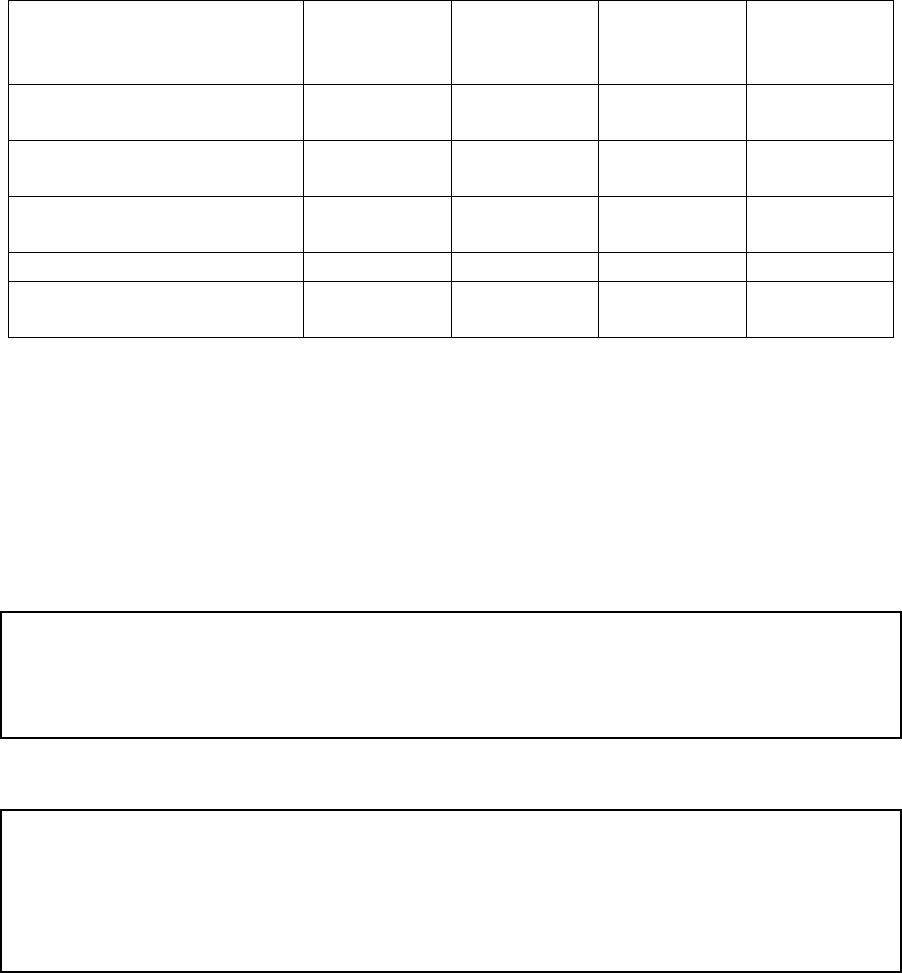
Range (100 bytes User
Data) / Transmit Rate
High
Speed
11 Mb/s
Medium
Speed
5.5 Mb/s
Standard
Speed
2 Mb/s
Low
Speed
1 Mb/s
Open Office Environment 160 m
(525 ft.)
270 m
(885 ft.)
400 m
(1300 ft.)
550 m
(1750 ft.)
Semi-Open Office
Environment
50 m
(165 ft.)
70 m
(230 ft.)
90 m
(300 ft.)
115 m
(375 ft.)
Closed Office 25 m
(80 ft.)
35 m
(115 ft.)
40 m
(130 ft.)
50 m
(165 ft.)
Receiver Sensitivity -83 dBm -87 dBm -91 dBm -94 dBm
Delay Spread
(at FER of <1%) 65 ns 225 ns 400 ns 500 ns
[Note]:
• In Open Office environments, antennas can “see” each other, i.e. there
are no physical obstructions between them.
• In Semi-open Office environments, work space is divided by shoulder-
height, hollow wall elements; antennas are at desktop level.
In Closed Office environments, work space is separated by floor-to-ceiling brick
walls.
CAUTION: To maintain compliance with FCC’s RF exposure guidelines, this equipment
should be installed and operated with minimum distance 20cm between the radiator and
your body. Use on the supplied antenna. Unauthorized antenna, modification, or
attachments could dama
g
e the transmitter and ma
y
violate FCC re
g
ulations.
This device complies with Part 15 of the FCC Rules. Operation is subject to the following
two conditions:
(1) This device may not cause harmful interference.
(2) This device must accept any interference received, including interference that may
cause undesired operation.
Basic Troubleshooting
If you cannot connect your USI 802.11b WLAN CF Card to the network, the
first troubleshooting hint is to verify LED activity of the CF Card . The LEDs
may show the following behavior:
• Power LED on, Transmit/Receive LED off
• Power LED on, Transmit/Receive LED flickering
• Both LEDs blink once every 10 seconds
• Power LED is Flickering
• No LED Activity
If there is LED activity, run the Client Manager diagnostic tool on your station
to:
• Run the Link Test to verify the quality of wireless network interface
radio communications with the network.
Power LED on, Transmit/Receive LED off
This LED status indicates normal operation:
• The USI 802.11b CF WLAN Card is powered on
• The Transmit/Receive LED indicates there is no activity on the wireless
network.
The absence of activity on the Wireless Network Interface might be related to
he fact that:
• You moved out of Wireless Range of the Base Station(s) that could
provide access to the selected network.
• There are no Wireless Client Stations in the Wireless Range of your
computer to participate in the selected Peer-to-Peer Group.
• The Base Station(s) that could provide access to the selected network has
(have) a problem (e.g. power is off).
Power LED on, Transmit/Receive LED flickering
This LED status indicates normal operation:
• The USI 802.11b WLAN CF Card is powered on
• The Transmit/Receive LED indicates activity on the wireless network.
If the radio of your USI 802.11b WLAN CF Card seems to communicate with
other radio devices, but does not succeed in actually connecting to the
network (i.e. the power and radio LED shows normal activity), you may need
to verify whether your operating system installed the correct Network Protocol
Settings.
Both LEDs blink once every 10 seconds
This LED indicates that the USI 802.11b WLAN CF Card is powered on
and working properly, but it is not able to establish a wireless connection
to the wireless network.
Possible causes might be:
• Your wireless station is outside the Wireless Range of the Base
Station(s) that could provide you access to the selected network.
• The Wireless Network Interface of your station has been configured
with an incorrect Network Name and/or Encryption Key settings.
• By mistake you selected a configuration profile on your wireless
station, that does not belong to the wireless network that you want
to connect to.
• The Base Station(s) that could provide access to the selected
network has (have) been configured to deny access to stations that
use the value ANY as their Network Name.
Contact your LAN Administrator for information about the correct values of
the parameter settings that apply in your network.
No LED Activity
If there is absolutely no LED activity on the Power LED and
Receive/Transmit LED of the USI 802.11b WLAN CF Card, this may be
due to one of the following reasons:
• The USI 802.11b WLAN CF Card device is not properly connected
to your computer.
• No driver was installed to allow communication between your
computer and the wireless network interface.
Power LED is Flickering
A flickering Power LED identifies that you enabled the Card Power
Management option for the USI 802.11b WLAN CF Card of a Wireless
Client Station (Advanced Settings).

Technical Support
The identification of the product :
Product Name : USI RoamUniversal 802.11b WLAN CF Card
Model Name : CF114100
Application : Handheld devices
Technical Contact :
Universal Scientific Industrial Co., Ltd. ( Headquarters )
Address : 135, Lane 351, Taiping Rd., Sec. 1, Tsao Tuen, Nan Tou,
Taiwan
USI Taipei Office : 10F, 420, Keelung Road, Sec. 1, Taipei, Taiwan
Contact Person : Ray Huang
Telephone : +886-2-2345-5006, Ext.119
Fax : +886-2-2345-5191
Email : rayhwang@ms.usi.com.tw
Technical Contact in the US :
Address : 685A Jarvis Drive, Morgan Hill, CA 95037, USA
Telephone : +1-408-776-1966
Fax : +1-408-778-5509
Website : www.usi.com.tw